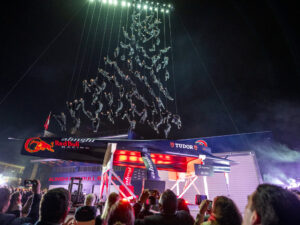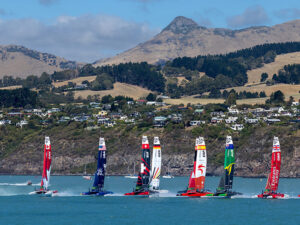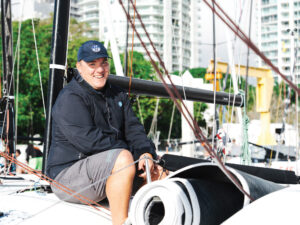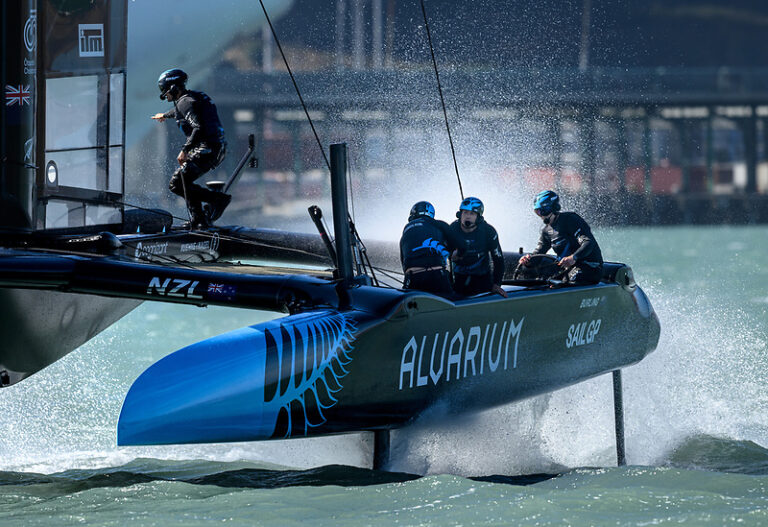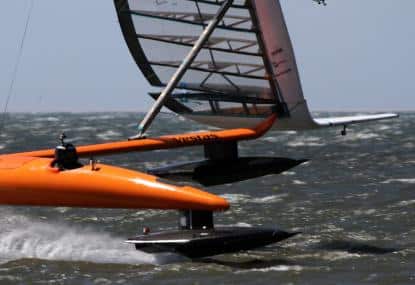
Sailrocket
How many times over the course of Paul Larsen’s singleminded, decade-long quest to break the outright speed sailing record did you scoff, scorn and doubt his oddball, waterbug craft? I know I did. Plenty.
For all we know, Larsen may have doubted Sailrocket as well. But what he didn’t do was give up. He never lost faith in the design concept, and in the numbers that said it would do 60-plus knots in 25-30 knots of wind. And that persistence, that Shackleton-level determination, turned out to be the most important quality in a 10-year quest for the Holy Grail of speed sailing. In the end it delivered a monster world record that wasn’t just an incremental step past the 55.65 knots that kiter Rob Douglas put up in 2010, but a giant leap (think Bob Beamon or Roger Bannister): 65.45 knots average over 500 meters, with a peak speed of 68.01 knots. Just as predicted for the winds. Wow, only in Larsen’s dreams would it go down like that.
After some serious celebration, Larsen settled down to explain how it took three runs to nail the new record (and how close to disaster he sailed). Here’s what he had to say about the record run:
We were using all the course this time. We hit it hard and the acceleration was rapid. We went straight into the 60’s. The pod was instantly high and I sheeted in as hard as I could to try and get it down. I was now adding a pre-fix to “fast”. It was now, “This is f*****g fast”. That word is there for moments like this. I believe it ceases to be swearing.
VESTAS Sailrocket 2 was alive and baring her base ventilated claws. We were in close and conditions were perfect. After 11 years, all the plates were spinning. The boat gave a hard kick in towards the beach that I had to steer into. I later found out that the rear skeg had dropped down and was dragging behind giving a fixed steering input. the boat settled into a balance. I thought it was something else related to the messy start up. I still thought something might be broken … but stuff it. I couldn’t see it, and whatever it was, it wasn’t slowing us down. We were hitting new highs. The timing hut was gone in an instant. I was vaguely aware of Malcolm and George standing on the shore in the shallows. It was just solid, hard speed now. I felt like the boat had forgotten about me and was now just showing itself what it could do. I was a passenger. The leeward pod continued to climb and climb.
Sheeting on wouldn’t put it down any more as it just generated speed and hence more apparent. I had no option but to sheet out and bring it all back under control. I ended up way down the end of the beach in the shallows. We survived. That had to be it … that was hard core fast. The boys came down and we got the boat ashore. Ben once again made the long walk down. I didn’t check the numbers. I knew it was 60 +.
That makes it almost sound easy. But before you dismiss Sailrocket’s triumph as inevitable, you need to remember this:
Photo: sailrocket.com
I highlight this picture, because until Sailrocket 2 started to show flashes that Larsen and his team were heading in the right direction, Sailrocket’s most notable legacy (apart from the fact that it always seemed to underperform expectations) was not one, but TWO!, impressive backflips. At speed.
This was the most spectacular (start at 3:35 if you are not interested in the set-up and just want to see the highlight):
But this one, a year later, is not bad, either:
Larsen makes the second flip sound almost routine, which is not really an aspect of speed sailing you want to be become routine. Most sailors (and sponsors) might have walked away at that point. But not Larsen. Here is what he told the website ClarkSail:
I think one of the things that most people have underestimated hugely about our project is the engineering that has gone on behind the scenes. Certain people came in when they were really needed, and this lifted the project to new levels. They only came in once they saw how determined we were. They knew their input wasn’t going to fall on deaf ears.
The second boat was no accident. Yes VESTAS did back it well financially, but they backed the exact same team that had cut their teeth on the first boat. That first boat should never have gone as fast as it did. It was flawed. It was like trying to sail an arrow backward and not many people know how difficult an engineering problem it was to make that boat work. However by the time we were done with that one, we had everything we needed to make a quantum leap forward in performance.
When I sat down with the design team to discuss the new boat I simply said it must do 65 knots in this much wind and satisfy certain stability criteria, i.e. full foil failure at top speed. A lot of our ideas were drawn up on a white board that day, but the final boat we are sailing now looks like none of them. It’s really a hybrid of a few of them. In the end it really designed itself. Yeah there was a rather large dose of determination, but this was also backed by some pretty clever people. We all worked extremely well together too. It has been a pleasure.
Which is a beautiful thing, because the moral of this story, beyond the sailing and engineering skill involved (even more from ClarkSail here), is that determination is probably the single most important quality that a human can bring to any great endeavor. Not everyone is a natural athlete or sailor, or an engineering genius. But anyone can be determined, and as long as that is so then there is no quest, no monumental goal, that is truly out of reach.
Now we can sit back and wait to see what sort of persistence and innovation the kiters and windsurfers can bring to bear in the challenge that Sailrocket and Larsen have laid down.
Thanks for that, too, because it will be fun to watch.
Photo: sailrocket.com


